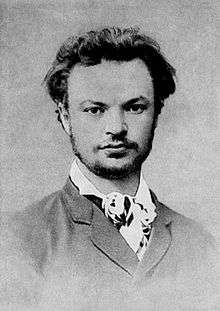Sergey Stepnyak-Kravchinsky
Sergey Mikhaylovich Stepnyak-Kravchinsky (Russian: Серге́й Миха́йлович Степня́к-Кравчи́нский; July 1, 1851 – 23 December 1895), known in the 19th century London revolutionary circles as Sergius Stepniak, was a Russian revolutionary mainly known for assassinating General Nikolai Mezentsov, the chief of Russia's Gendarme corps and the head of the country's secret police,[1] with a dagger in the streets of St Petersburg in 1878.
Sergey Stepnyak-Kravchinsky | |
|---|---|
 | |
| Born | July 13, 1851 |
| Died | December 23, 1895 (aged 44) |
Early life
Stepniak was the son of an army doctor and of a noblewoman, born July 1 (O.S.; July 13 N.S.), 1851 in Novy Starodub, Ukraine (then part of the Alexandrovsky Uyezd, Kherson Governorate of the Russian Empire).[1] He received a liberal education, and when he left school, he went on to attend Military academy and the artillery school before joining the Russian army. He reached the rank of second lieutenant before resigning his commission in 1871.
Revolutionary life
His sympathy lay with the peasants, among whom he had lived during his boyhood in the country, which developed in him at first democratic and, later, revolutionary opinions. Together with a few other men of birth and education, he began secretly to sow the sentiments of democracy among the peasants, as a member of the Circle of Tchaikovsky. His teaching did not long remain a secret, and in 1874 he was arrested.[2]
He succeeded in making his escape, possibly being permitted to escape on account of his youth, and immediately began a more vigorous campaign against autocracy. His sympathetic nature was influenced by indignation against the brutal methods adopted towards prisoners, especially political prisoners, and by the stern measures which the government of tsar Alexander II felt compelled to adopt in order to repress the revolutionary movement.[3]
.jpg)
In 1874 Stepniak went to the Balkans and joined the rising against the Turks in Bosnia in 1876, and used that experience to write a manual on guerrilla warfare. He also joined the anarchist Errico Malatesta in his small rebellion in the Italian province of Benevento in 1877. He returned to Russia in 1878, joining Zemlya i volya (Land and Liberty), where he along with Nikolai Morozov and Olga Liubatovich edited the party journal.
For a time he was convinced that individual acts of political terrorism would convince tsar Alexander II to introduce democratic reforms. On August 4, 1878 O.S. he assassinated General Nikolai Mezentsov,[4] the chief of the Gendarme corps and head of the country's secret police,[1] with a dagger in the streets of St Petersburg.
After the killing, he exposed himself to danger by remaining in Russia, and in 1880 he was obliged to leave the country. He settled for a short time in Switzerland, then a favourite resort of revolutionary leaders, and after a few years came to London. He was already known in England by his book, Underground Russia, which had been published in London in 1882.[5] In England he established the Society of Friends of Russian Freedom and the Russia Free Press, linking with Karl Pearson, Wilfrid Voynich and Charlotte Wilson. He was also an editor for the Society's house organ, Free Russia.
He followed up Underground Russia with a number of other works on the condition of the Russian peasantry, on Nihilism, and on the conditions of life in Russia. His mind gradually turned from belief in the efficacy of violent measures to the acceptance of constitutional methods. In his last book, King Stork and King Log, Stepniak spoke with approval of the efforts of politicians on the Liberal side to effect, by argument and peaceful agitation, a change in the attitude of the Russian government towards various reforms.[5]
Stepniak constantly wrote and lectured, both in Great Britain and the United States, in support of his views, and his energy, added to the interest of his personality, won him many friends. He was chiefly identified with the Socialists in England and the Social Democratic parties on the Continent; but he was regarded by people of all opinions as an agitator whose motives had always been pure and disinterested.[5]
Stepniak was killed by a train at a railway crossing at Woodstock Road, Chiswick, London, where he resided, on 23 December 1895 (see Stepniak's death on the railway).[5] He was cremated at Woking on 28 December.[5]
Notes
- Saunders 2005.
- Fyfe 1911, p. 889.
- Fyfe 1911, pp. 889–890.
- Kropotkin 1905.
- Fyfe 1911, p. 890.
References
- Kropotkin, Peter (1 January 1905). "The Constitutional Movement in Russia". revoltlib.com. The Nineteenth Century.
- Saunders, David (May 2005). "Sergey Mikhailovich Kravchinsky (1851–1895)". Oxford Dictionary of National Biography (online ed.). Oxford University Press. doi:10.1093/ref:odnb/62226. (Subscription or UK public library membership required.)
Attribution:

Further reading
- The Anarchists, James Joll, second edition, page 103.
- The World That Never Was: A True Story of Dreamers, Schemers, Anarchists & Secret Police, Alex Butterworth, first edition, page 92.
S. M. Stepniak-Kravchinskii: The London Years. [Senese, Donald] /Newtonville -ORP- 1987/, pp. 130, ill. hc.
External links
| Wikimedia Commons has media related to Sergei Kravchinski. |